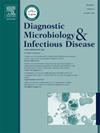重症肺结核诊断模型的建立与评价
IF 2.1
4区 医学
Q3 INFECTIOUS DISEASES
Diagnostic microbiology and infectious disease
Pub Date : 2025-06-05
DOI:10.1016/j.diagmicrobio.2025.116946
引用次数: 0
摘要
由于缺乏可靠的生物标志物,延误了管理和风险预测,诊断严重肺结核(PTB)仍然具有挑战性。本研究旨在确定严重肺结核的关键危险因素,并建立早期评估和干预的预测模型。方法在2022年1月至2023年12月期间,纳入182例PTB患者,并将其分为非重度PTB (n = 112)和重度PTB (n = 70),重度PTB定义为胸片上涉及三个或更多肺野的活动性PTB。统计数据、血液学参数、血管内皮生长因子(VEGF)和炎症标志物进行分析和比较。使用回归模型确定严重肺结核的危险因素。采用显著变量构建诊断nomogram,并通过受试者工作特征(ROC)曲线分析评估预测效果。结果分析发现患者有糖尿病史(优势比[OR] = 3.258),系统性炎症反应指数(SIRI;OR = 2.742),较高的VEGF (OR = 1.011)和IL-6水平(OR = 1.069)是严重PTB的独立危险因素。随后使用这些因素开发了诊断nomogram。ROC分析表明,该模型的ROC曲线下面积为0.866 (P <;0.001),敏感性为80%,特异性为83.04%,约登指数为0.630,显著优于个体因素(P <;0.05)。独立验证证实了其稳健性。结论结合糖尿病、SIRI、VEGF和IL-6的预测模型能够可靠地早期评估严重PTB的风险,促进有针对性的干预,改善临床结果。本文章由计算机程序翻译,如有差异,请以英文原文为准。
Establishment and evaluation of a diagnostic model for severe pulmonary tuberculosis
Background
Diagnosing severe pulmonary tuberculosis (PTB) remains challenging because of the absence of reliable biomarkers, delaying management and risk prediction. This study aimed to identify key risk factors for severe PTB and develop a predictive model for early assessment and intervention.
Methods
Between January 2022 and December 2023, 182 patients with PTB were included and categorized as having non-severe PTB (n = 112) or severe PTB (n = 70), defined as active PTB involving three or more lung fields on chest radiography. Demographic data, hematological parameters, vascular endothelial growth factor (VEGF), and inflammatory markers were analyzed and compared. Risk factors for severe PTB were identified using regression models. Significant variables were used to construct a diagnostic nomogram, with predictive performance evaluated via receiver operating characteristic (ROC) curve analysis.
Results
The analysis identified a history of diabetes (odds ratio [OR] = 3.258), a higher systemic inflammation response index (SIRI; OR = 2.742), and higher VEGF (OR = 1.011) and IL-6 levels (OR = 1.069) as independent risk factors for severe PTB. A diagnostic nomogram was subsequently developed using these factors. ROC analysis demonstrated that the model achieved an area under the ROC curve of 0.866 (P < 0.001), sensitivity of 80 %, specificity of 83.04 %, and Youden index of 0.630, significantly outperforming the individual factors (P < 0.05). An independent validation confirmed its robustness.
Conclusions
A predictive model incorporating diabetes, SIRI, VEGF, and IL-6 enables reliable early risk assessment of severe PTB, facilitating targeted interventions and improving clinical outcomes.
求助全文
通过发布文献求助,成功后即可免费获取论文全文。
去求助
来源期刊
CiteScore
5.30
自引率
3.40%
发文量
149
审稿时长
56 days
期刊介绍:
Diagnostic Microbiology and Infectious Disease keeps you informed of the latest developments in clinical microbiology and the diagnosis and treatment of infectious diseases. Packed with rigorously peer-reviewed articles and studies in bacteriology, immunology, immunoserology, infectious diseases, mycology, parasitology, and virology, the journal examines new procedures, unusual cases, controversial issues, and important new literature. Diagnostic Microbiology and Infectious Disease distinguished independent editorial board, consisting of experts from many medical specialties, ensures you extensive and authoritative coverage.

 求助内容:
求助内容: 应助结果提醒方式:
应助结果提醒方式:


